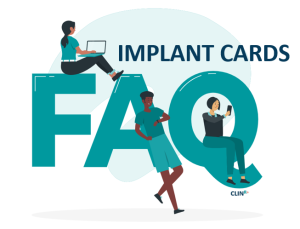Implant Cards FAQs

Q: What is the purpose of implant cards under EU MDR?
A: Implant cards are required under Article 18 of EU Regulation 2017/745 on medical devices. They provide patients with essential information about their implanted medical devices and improve patient safety in various scenarios.
Q: What devices are considered "implantable devices" under the MDR?
A: An implantable device, as defined by MDR, is one that is intended to be totally introduced into the human body, to replace an epithelial surface or eye surface, and is intended to remain in place after clinical intervention. Devices partially introduced and intended to remain for at least 30 days are also considered implantable.
Q: How do implant cards improve patient safety?
A: Implant cards enhance patient safety by:
- Providing accurate information about the implanted device, including name, serial number, and lot number.
- Offering practical identification for special attention needs, such as airport security.
- Assisting emergency responders by indicating the presence of an implanted device during medical emergencies.
Q: Are there guidelines for creating implant cards?
A: Yes, the Medical Device Coordination Group (MDCG) provides guidelines. The MDCG document MDCG 2021-11 “Guidance on Implant Card – Device Types” lists devices falling under the regulation. MDCG 2019-8 outlines specific instructions for the card’s appearance and required information.
Q: What information should be included on the implant card?
A: The card should contain:
- Device name
- Device type
- Serial number or lot/batch number
- Unique Device Identification (UDI)
- Manufacturer’s name, address, and website
- Blank fields for patient information (to be filled by healthcare providers)
- Patient name or ID
- Implantation date
- Healthcare provider’s name and address
Q: Are there specific formatting requirements for the implant card?
A: Yes, the card must be wallet-sized (credit card, ATM card, or ID card), with all text at least 2 millimeters high and easily understood. The information must be in the language of the relevant member state. The UDI-DI and UDI-PI should be in human-readable format.
Q: When do the implant card requirements apply?
A: The requirements apply to devices placed on the market under EU MDR 2017/745. They do not need to be provided retrospectively.
Q: What is the role of manufacturers in complying with Article 18?
A: Manufacturers are required to have a website to communicate with patients who have implanted devices. They must demonstrate compliance with Article 18 and justify their approach. An information leaflet should also accompany the implant card.
Q: Are all implantable devices required to have an implant card?
A: Except for devices on the exemption list in Article 18, all implants must have an implant card that meets the requirements.
Q: What is the significance of the UDI-DI and UDI-PI on the card?
A: The UDI-DI and UDI-PI (Unique Device Identifier-Device Identifier and Production Identifier) must be included on the card in human-readable format. The UDI-DI should also be in automatic identification and data capture format, such as barcodes.
Q: Are there any additional considerations for implementing implant cards?
A: It’s advisable to use internationally recognizable symbols on the implant card, as suggested by MDCG guidance. Manufacturers must ensure that all required information is present on both the implant card and their website to provide comprehensive information to patients.
Q: What is the purpose of the information leaflet accompanying the implant card?
A: The information leaflet provides supplementary information to patients about their implanted device and complements the implant card’s content. It contributes to patient awareness and safety.



